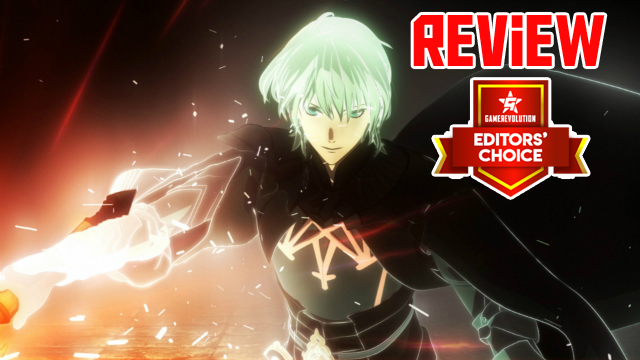Fire Emblem: Three Houses brings the series to a new platform, and in many ways is a new beginning for the franchise. There have been massive changes introduced, which can be concerning since Fire Emblem has been relatively consistent in its mechanics for almost all 30 years of its existence. Thankfully, although many systems have been tweaked, removed, or added, Fire Emblem: Three Houses keeps enough of the series’ core that it’s instantly recognizable and enticing to long-time fans.
The biggest expansion Three Houses brings to gameplay is the life-sim part of the game. Unlike previous entries, which had you speaking with your comrades via a menu or small hub area, Three Houses gives you an expansive home base, Garreg Mach Monastery, which is filled with activities, people to talk to, items to collect, and optional content. The combat system is also changed, forgoing the franchise’s trademark weapon’s triangle in favor of more nuanced fighting. The result brings much life to the series and makes it one of the best to date.
ALSO: Best Fire Emblem games, ranked | From Sacred Stones to Path of Radiance
Fire Emblem: Three Houses Review | Back to school
For the first half of Fire Emblem: Three Heroes you’re a professor at the Officer’s Academy at Garreg Mach Monastery. Though your character is young, your daring rescue of a group of very important nobles at the beginning of the game impresses Rhea, Archbishop of the Church of Seiros and the one in charge of Garreg Mach and the academy. Your first order as a professor is to choose which of the three houses you wish to teach.
The Black Eagles, Blue Lions, and Golden Deer all contain students that represent one of the three major political powers on the continent of Fodlan, where the game takes place. This choice is the most important in the game and will determine how you spend the next 70 or so hours it’ll take to finish the game. You’ll spend the first half of the game taking on missions from the church and molding your students from spoiled nobles into a powerful, first-class fighting force. During the process, you’ll get to know them, and learn that there’s more to them than meets the eye.
The excellent characters are made all the more intriguing because of the tangled web of political connections they have. Fodlan is made up of the Adrestian Empire to the south, the Kingdom of Faerghus to the north, and the Leicester Alliance to the east. Each house of students hails from one of these countries, which are enjoying a period of peace between them.
As you progress through the game, you learn more about each country and each student’s position in them. Things are made complex by the fact that the Kingdom of Faerghus split from the Adrestian Empire, then the Leicester Alliance divided from the Kingdom of Faerghus. This means that there’s a ton of old animosities seething below the service waiting to burst out at any moment. The Church of Seiros, the de facto religion of Fodlan, also has its own problems, within and without, which bubble up during the game’s first half.
I don’t want to ruin any details that haven’t already been spoiled by the trailers, so I won’t go into too much further detail on the story. The ramp-up through the first half into the time jump gets you very invested in Fodlan’s people and history, which makes the war that takes up the second half of the game that much more jarring and poignant.
Fire Emblem: Three Houses Review | With a little help from my friends.
The character development in Three Houses is excellent. I chose to lead the Blue Lions, and in particular, the relationship between Dedue and Dimitri is incredibly complex. Dedue is a member of the Duscar people, who are a pariah in their Kingdom since they are said to have rebelled and killed the king. The king happened to be Dimitri’s father, and in retaliation, Dimitri and the royal army basically went scorched earth on the Duscar. However, despite this, Dimitri befriends Dedue instead of killing him and takes him into his service.
The relationships between characters grow and develop between characters as the game goes on. The support system returns, and it’s through this that you’ll learn much about your students and their relationships with one another. When units perform actions near each other in battle or heal each other, they’ll gain support points. Gain enough of these, and you’ll unlock interactions between them that tell a story. Almost everyone has three support levels: C, B, and A. Byleth (the default name of the main character) can achieve an S rank, but only with one person. Whomever you S rank with the game will then treat as your romantic interest.
While I loved the characters in Three Houses, there is an aspect missing from the support system that I think stifled their development. In previous Fire Emblem games, characters could reach S rank support with each other, get married, and even have children. In Three Houses, the only person that can pursue a soul mate, or really have any sort of romantic involvement at all is the main character. Somehow, no matter how close members of your house seem they’ll never fall in love or do anything outside of some flirting.
It seemed incredibly strange, especially after the time jump that marks the halfway point of the game that in all that time no one got married, fell in love, had children, or any had notable romantic involvement. It’s not a game-breaker, but when you spend 70 hours with a group of characters and get to know their backstories, motivations, and aspirations in such detail, it fills like there’s a bit of a hole there. The one exception in my Blue Lions playthrough was Sylvain, who is implied to be banging pretty much anything that will let him. However, you can’t tell me that he never managed to hook up with any named character.
Fire Emblem: Three Houses Review | Home is where the heart is.
Garreg Mach Monastery is where you’ll spend much of your time in Three Houses. Whereas previous Fire Emblem games were about 80% combat and 20% everything else, in Three Houses the ratio is flipped. While you’ll still get plenty of chances to step out onto the field of battle, the addition of Garreg Mach and the teaching mechanics means you’ll spend most of your time speaking with the inhabitants of the monastery, growing your student’s stats through classes and lectures, and growing your relationships with characters through side activities like tea parties, cooking, and eating meals together.
I found that time at the monastery gives Three Houses a more concrete feeling than other Fire Emblem games. Although the 3DS entries have had little hubs where you can talk to characters and complete activities, they very much feel like hubs. Garreg Mach is to scale and feels alive with students, monks, and knights walking to and froe. Little touches do much to add to this feeling that it’s a real place. Every student and teacher has their own room, even if during the day you don’t find them there. If you give someone a bouquet of flowers, for example, you can find it in their lodgings if you visit later on.
Teaching gives you a chance to mold your characters in ways you couldn’t in previous titles. While you still have to gain levels from good ol’ combat, proficiencies can be molded and grown through weekly classes. Each of your allies has a particular set of goal proficiencies that they start with, but you can change these at will, and sometimes characters will even suggest new ones for you. You do still need to follow a character’s archetype if you want them to perform their best, Dimitri wouldn’t make a great healer/magic-user, but you have the option.
Fire Emblem: Three Houses Review | Mortal combat.
The ability to have so much choice over your character’s proficiencies gives you an unprecedented amount of control over your party’s composition. The game is long enough that you have the chance to multi-class characters and switch them according to your needs. If you’re playing on a large map with a lot of space between enemies, you could switch the majority of your party to horseback or flying classes. Alternatively, if you’re on a smaller map crowded with foes, you could focus on more balanced or tank classes.
Adding to the freedom is the elimination of the weapons triangle. Shadow of Valencia also didn’t use the weapons triangle, but in Three Houses the decision feels more cohesive than arbitrary. No longer do you have to start sweating bullets if a unit equipped with a lance attacks your sword-wielder. Instead, like in traditional RPGs, damage depends on your base stats plus whatever bonus your equipment confers. There are some vestiges of the weapon triangle left, like bows doing massive damage to flying units and magic being effective against heavily armored units, but for the most part, you’re more free to engage the enemy than in many past games.
There’s more of an emphasis one abilities in Three Houses than most fans are used to as well. As you rise in proficiencies, you gain access to both Abilities and Combat Arts. Abilities are passive skills that can be equipped to buff specific stats. Combat Arts are attacks that do more damage or do special damage, at the cost of weapon durability. Also, you can gain skills and arts by equipping and mastering classes. Master a class, and you can use its abilities permanently.
Adding to the combat options is the Battalion system. About an eighth into the game, you gain the ability to equip characters with their own battalions of troops. By activating them using the Gambit option, you can unleash a powerful attack that can leave the enemy reeling. These Battalions can level up and have their own set of stats just like a mini-character of sorts.
Fire Emblem: Three Houses Review | Take me to school.
Fire Emblem: Three Houses is my favorite entry in the series so far. The addition of Garrag Moch Monastery and the activities within gave a lot of balance to the game that previous Fire Emblems lacked. While I’ve loved the series for years, Three Houses keeps you excited for more. By the time I’m tired of hanging around the academy, it’s time for a fight, and by the time I’m done with fighting, I get to spend another hour or so hanging out with my students.
The lack of any romantic development outside of the player avatar is a bit frustrating, as it leaves a hole in some otherwise amazingly-written characters. I loved getting to know the Blue Lions during my playthrough and the fact there are three (and a half if you count the hidden route) almost entirely different paths through the game depending on which house you pick gives it a ton of replayability. This is a game you can easily spend 200+ hours with and still not have completed all the story content.
Fire Emblem: Three Houses is far from just an upscaling of the 3DS games. It’s an evolution for the series which makes it appealing and accessible even to those who aren’t crazy about strategy RPGs. It’s a great gateway for the genre and another excellent addition to the Switch library.
-
Addition of a plethora of RPG elements helps pacing significantly.
-
More freedom to build your allies than in previous Fire Emblem titles.
-
Three (and a half) possible routes through the game gives 200+ hours of playtime.
-
Only the main character can develop a romance and it only blossoms at the end of the game.
-
Very well-written and interesting characters.











